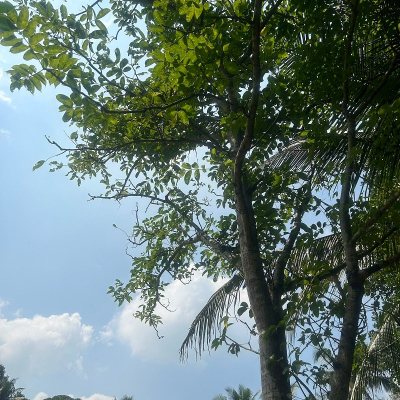Distribution and habitat: Throught out India, wild as well as cultivated.
Botany: A medium sized aromatic, deciduous tree, upto 27 m in height.
- Leaves: Compound, crowded at the ends of the branches, leaflets large having parallel nerves meeting in an intramarginal nerve.
- Bark: Thick, surface light grey to grayish bark, shallowly furrowed or cracked longitudinally, brittle, their fracture splintery.
- Flowers: Many, in terminal spreading panicles. Starts flowering 2-3 years after sowing.
- Fruits: Fleshy drupes with woody endocarp, surrounded by longitudinal interwoven fibrous, young fruits green colour, turning light yellow or greenish yellow on ripening. One seed per drupe.
- Seeds : The stone is semi-woody, 2.5 cm long and 2.1 cm diameter, fibrous outside, 5 celled, polyembryonic. Seeds mature in 8 to 9 months after flowering during December to May
Properties:
- The bark is aromatic, astringent and refrigerant.
- The leaves are aromatic, acidic, astringent.
- The unripe fruits are astringent, thermogenic, appetizer and aphrodisiac. The ripe fruits are sweet, astringent, cooling, emollient, tonic, constipating and antiscorbutic.
Uses:
- The leaves are used in dysentery. The juice of the leaves is recommended for local application in otalgia.
- The unripe fruits are used in dysentery. The ripe fruits are used in bilious dyspepsia, diarrhea, general debility.
- The bark is useful in dysentery, diarrhea, vomiting and muscular rheumatism.
- The roots are useful in regulating menstruation.
Agrotechnology
Propagation: To collect seeds, fruits are squeezed under water to remove the pulp. The stones are then dried under partial shade and stored. It has 2-3 months of dormancy. Seeds remain viable only up to 7 months. Overnight soaking of seed in water is preferred before sowing. It takes 17-20 days to germinate after sowing. One month old seedlings are ready to be transplanted in the prepared fields.
Spacing : 5 m x 5 m
Seed requirement per acre : 1 kg
Seedlings required per acre: 160 nos.


